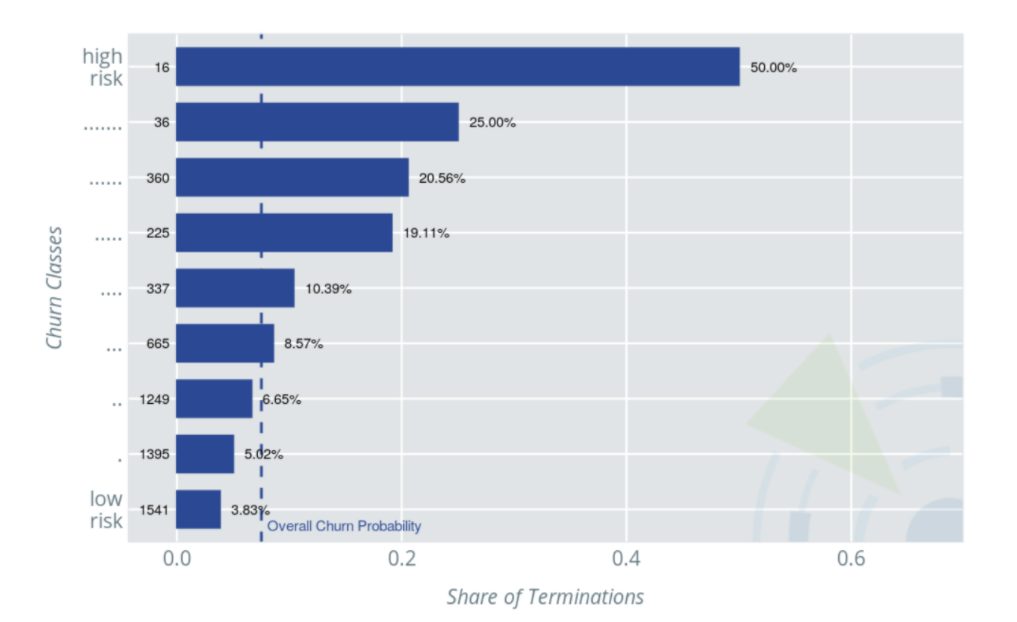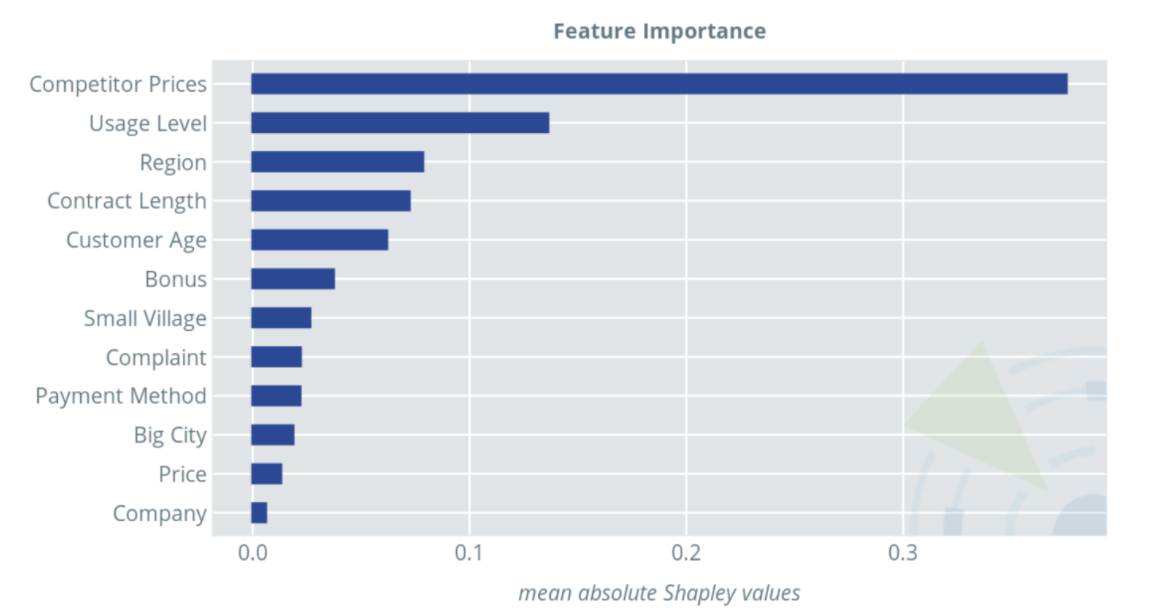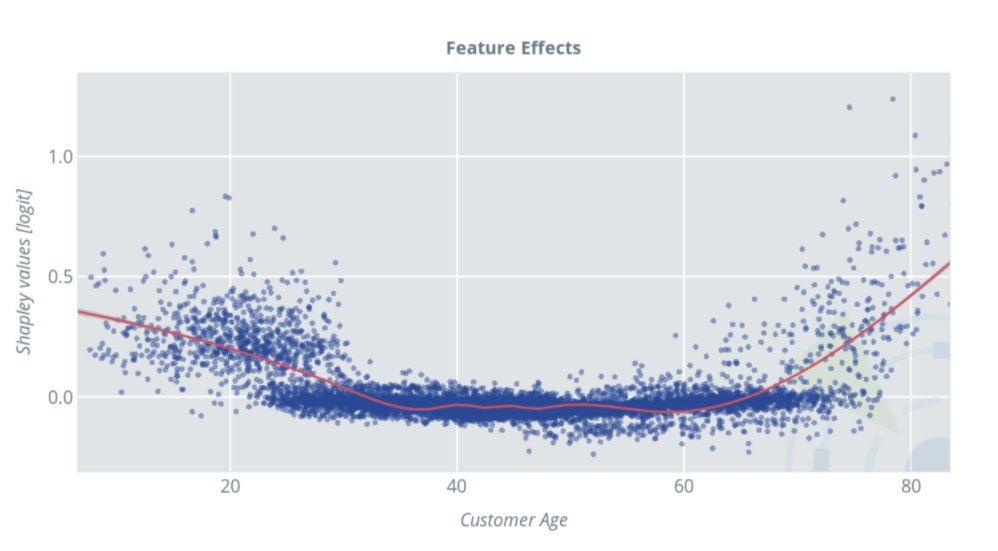Churn Analysis for Attracting and Retaining High-Value Customers
Data-driven approaches to maximizing customer relationships are more important than ever in today’s highly saturated and competitive markets. There are many steps a proactive business can take to positively position themselves to keep high-value customers and prevent customer churn.
What is customer churn, and why is it important?
Customer churn - otherwise known as customer attrition - is when a customer stops making purchases or cancels their contract with a company.
Churn is typically measured as the rate of customers who end their business relationship over a certain timeframe. Churn rate is a critical metric, since an increased churn rate can indicate that adjustments to the company (marketing) strategy are needed to improve customer retention.
There are many reasons why keeping existing customers is even more important than new client acquisition. For example, acquiring new customers is much more expensive than keeping existing customers - between 5 and 25 times more. Customer relationships also become more valuable over time, as operating costs to serve them decline and their inclination to purchase increases. Loyal clients may also refer new customers through their social networks. In concrete terms, research by Bain & Company found that just a 5% increase in customer retention improved profits by over 25% in some sectors.
Traditionally, one might think of incentivizing customers to stay engaged through marketing campaigns. However, simply extending a campaign to all clients may be inefficient, as only a minority of them may actually have required an incentive to re-purchase, making the rest of the campaign budget an unnecessary expense. Ideally, we would want to proactively adjust our marketing strategy and only target those customers at risk of churning.
What is a churn analysis?
Churn analyses can help businesses to determine which customers have the highest probability of churning, and what attributes are associated with this higher likelihood of attrition.
It’s quite possible to have an intuition for which factors are important - maybe price, contract length, or the type of items a customer typically buys - but given the diversity of characteristics that may play a role, and potential interactions between them (perhaps certain behavior is predictive of churn for customers in a particular age and gender group, for example), a data-based approach is the most robust way to ensure that customers are being properly targeted.
How does churn analysis work?
Data
One of the reasons that churn analyses are so powerful is that the essential data needed are quite readily available for most companies. While analyses can include data from many sources - such as customer feedback or social media - good results can be achieved from simply a customer’s purchase history and basic CRM data.
Methods
The more complicated aspect is determining the appropriate model. There are many models that could potentially be suitable, with the key being to balance having an accurate model that correctly classifies clients with a model that is interpretable, so that the results can help guide marketing decisions effectively.
Some options include:
- Logistic regression, a classical approach that can have quite good results and is relatively interpretable. It is often employed as a baseline before using a more complicated model for the final results.
- Survival analysis, which is useful as it can deliver a timeline for customer retention. This technique shows not only whether a customer is likely to end their relationship with the company, but also when this is predicted to happen.
- Relational classifiers that can consider a customer’s social network when making predictions.
- Machine learning models like random forests, XGBoost, and support vector machines, and deep learning approaches using neural networks which offer superior predictive performance, but at the cost of interpretability. Luckily, interpretable machine learning techniques can help us to overcome this challenge, which is described in a bit more detail below.
A company’s particular needs and use case should guide the choice of the appropriate model. Consideration of company-specific factors can also help to figure out which variables are relevant, and to determine the optimal timeframe to consider for the model. For example, some companies may be able to look at churn on a monthly basis, whereas others with a lower purchase frequency could use quarterly or even yearly evaluation periods. Additionally, for contract-based businesses churn is easily determined by the termination of a contract, but for transaction-based business models churn must be defined by considering average transaction frequencies or other nuances of the customer relationships for a particular company.
How can churn analyses be used?
Learning about customers
Churn analysis can generate risk profiles on the individual or group level. Even if it is not feasible to customize a marketing strategy for each individual, a churn analysis can create customer segments so that a company can determine which customers are in the low, middle, and high churn probability groups.

Using explainable machine learning techniques, it is also possible to determine not only whether a customer is likely to churn, but why.
This can be done “globally”, by examining the most important features that explain the predicted churn probabilities, or locally on the individual customer level.

Feature importance for a churn model using Shapley values. Competitor prices are the most important factor for dictating churn probability in this example.

Using interpretable machine learning techniques, it is possible to see the effect of a particular feature (like age) on customer churn probability.

It is also possible to isolate the effects of various features on an individual customer’s predicted churn probability. In this example, the contract price has greatly increased the customer’s churn probability, while their long relationship with the company has decreased it.
These insights can be integrated into a CRM and continuously updated so that new customers are added and changes in marketing strategies, season, or other dynamic factors can be reflected on an ongoing basis. This also allows for targeted customer service responses during customer interactions, anticipating what might be problematic for an individual customer when they call.
Efficiently targeting marketing campaigns
By integrating churn probability into the marketing strategy, budgets and energy can be efficiently allocated to target those customers most at risk of churning, and can be tailored based on their predicted reasons for doing so. This saves funds by not running campaigns for customers that would have purchased regardless, which can make a significant difference in overall marketing spending.
For example, a company may be considering running a campaign offering a reactivation bonus. By calculating the probability that the customer would repurchase within the next few weeks both with and without the bonus, it is possible to only target those customers with a high uplift from a marketing touch.
Acquiring high-value new customers
Companies often make the mistake of focusing on simply acquiring more customers, without concern for the quality of the customer relationship over time. A churn analysis can help to forecast the gains from a customer, such as the predicted contract length.
This insight can have further effects beyond just steering acquisition budget. For example, imagine that a company has just started to work with a new marketing team, and they are thrilled to find that their customer base is growing rapidly. The company may consider investing in additional staff or infrastructure. But what if it turns out that these are not customers that are likely to work with the business long-term? These ill-advised investments could be avoided with a proper churn model. Similarly, a churn analysis can help focus customer acquisition on channels that may be more expensive, but deliver loyal customers that generate higher profits in the longer term.
Gaining insights and adjusting strategy
Churn analysis may also offer insight into larger company strategy and appropriate areas for prioritization. For example, here at INWT we conducted a churn analysis for a company involved in selling a service B2B which involved some initial technical setup. The results from our analysis showed a surprising finding: Customers calling the support center one to two times had a lower churn probability than customers that never called, or that called more than twice. The explanatory power of the corresponding variable was notably high.
Prior to this analysis, the company saw the support center only as a cost factor, not paying too much attention to the unit from a strategic perspective. Because the result seems implausible at first, some further research was conducted: It turned out that while there were some customers managing to do the technical setup on their own, most customers failed with this task. Among those, some resigned (and therefore did not consider calling for help - they simply cancelled their contracts) while others still believed in the value of the product and called the support center to give it a second try. Those who managed to do the technical setup with the assistance of the support center became loyal customers. Only a small group of customers didn’t manage to overcome the technical issues even with the help of the support hotline, and also ultimately cancelled their contracts. Those valuable insights produced by the churn model led to a whole new perception of the support center. Instead of being a just cost factor, it was recognized as a crucial part of onboarding of new customers. Additional resources directed into the support center proved to reduce churn and paid off well.
Extension to other analyses
Churn prediction is also useful because of its extensibility to other analyses. Churn probability can be a core component for customer segmentation, uplift analyses, or customer lifetime value prediction.
The latter is particularly relevant: While it is certainly possible to prioritize customers who have historically spent a higher amount and are likely to churn, an even better approach is to forecast a customer’s future potential when determining the proper marketing strategy.
Conclusion
Churn analyses offer some of the greatest return on investment for companies looking to expand their data-driven marketing strategies. The data needs are modest and approachable for nearly all firms, and the effect of saving marketing budget by targeting only those customers most likely to end their relationship with the firm and tailoring marketing decisions to proactively respond to customer concerns can be significant. The potential gains are augmented even further with the choice of the appropriate model and explainability strategies.
A churn analysis is a great data science project to start with. It is relatively easy to implement with only moderate requirements for data. It creates an immediate impact on the individual level, and generates valuable insights that can help to improve business processes. On top of all that, it creates synergies with various other marketing projects (like customer lifetime value, customer segmentation, upselling).